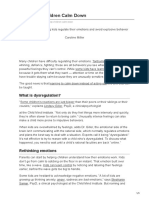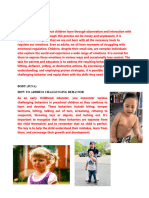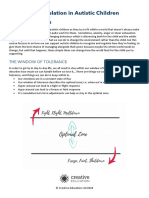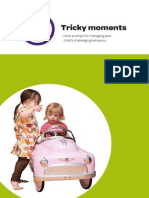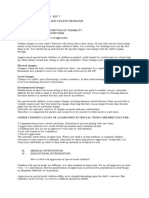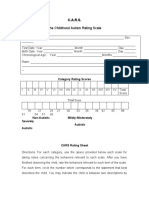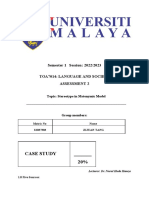5 top tips for de-escalating tricky situations
1. Be sympathetic.
What seems unimportant for you might be hugely important for them. When a child gets upset because she
wanted blue socks and you gave her red, we think to ourselves, “what’s the big deal?”. It is important to
always validate their emotions, not negate them. If they find value and importance in something, it won’t do
any good to tell them that their understanding of importance is incorrect.
2. Give space, but don’t isolate.
children with an inclination toward anger will often have an inclination toward physical aggression.
Providing outlets for this such as punching a pillow or squeezing a blanket will help relieve this tension. A
calm down zone/toys/activities provide an appropriate outlet for this aggression. The child might not like to
feel isolated from the group or activity when upset, but a bit of space can be a good thing.
3. Remind them that anger is ok.
Emotions are a normal part of our development, and we experience a range of them every day. It is
perfectly fine to get mad, to become angry. Any consequences that you provide for the child while they are
upset should always be for behaviours, not for the emotion.
4. Don’t over-react.
Model a calm voice and a calm demeanour. Use the language and consequences you have decided in your
planning, stick to them!
5. Listen
Children need to feel heard, especially when upset. By validating their feelings and letting them tell their
side dramatically helps them feel that way. Allowing them to talk about how they are feeling will help make
leaps and bounds toward calming down.
When dealing with an angry or frustrated child: keep a long-term view
Be calm and stick to the plan
First things first, control your own emotions. In moments like this, your reaction sets the tone for how the
rest of this rough moment will play out. You want to be calm, so you can help the child get calm. Be the
thermostat, not the thermometer. Having a set plan on how to deal with each child takes the emotion away.
Keep talking to a minimum.
When a child is in fight, flight or freeze mode, they can’t process information as well as when their body is
in rest and digest mode. It’s best to keep talking to a minimum at this point. It is not a teachable moment,
and they can’t take in a lecture at this point. Your goal is to get them through this rough moment. When you
talk with them, keep it short and repeat the same phrase. Repeating it is helpful because they aren’t
processing things as they normally would, so the repetition can help them hear it.
Get them to a calm, safe spot
When some kids get big feelings, they destroy items around them, or may hurt others. If that’s the case for
this child, it may be helpful for you to set up a safe spot where they can go when they are angry. It may be
a calm down zone – big box, pup tent, bean bag, corner tucked away with some privacy if possible.
If you aren’t in the safe spot when the child is having an outburst – try to move them towards a ‘safe zone’,
get the other kids out of the way or take something to them to calm them down (from the emergency box)
as a distraction or to hide them (blanket, box etc).
If a child is really ‘out of control’ they will be unaware of the surroundings and in the zone. If they are still
checking to see who is looking or following you around, they are not ‘out of control’.
After it’s over, debrief
After it’s all over, when the child is calmer and in better space, take a few minutes and talk about what
happened. Keep the conversation simple. What do they remember? What helped? What didn’t help? This
conversation doesn’t have to take place immediately after the incident is over. It could happen later that
session. Or maybe the next day.
©decodingadhdtraining
� If another child/children was present, be sure to take a few minutes to check in with them too. Let them
express how they felt and talk about what they can do next time something like this happens. Also, debrief
with other team members, it’s a good idea to keep track of these patterns and what helps when checking
your planning and what is working or not.
Be preventative
One of the best things you can do is work on teaching coping skills kids can use before things escalate to
epic proportions. The trick is practicing when they are in a calm and relaxed mood, not in the moment when
they are angry. Use role playing to get the child familiar with the scenario and practise using the right
words or actions.
Talk about it
Start by talking about what’s making them frustrated or angry. Help them identify those triggers, so you
both know for the next time. Is it an activity that makes them frustrated? Have they had a bad day? Perhaps
being hungry or thirsty? Are their certain noises or locations that are frustrating?
Where do you feel it in your body?
Sometimes, kids don’t know they’re angry until after the explosion has happened. Next help them identify
signs in their body, so they know when they’re feeling frustrated. Through the identification of those signs in
their body, it can help them start to recognize that feeling and eventually intervene with a coping skill
earlier.
Identify and practice coping skills
Now that they know what causes those big feelings and how to identify them, help them figure out ways to
deal with those feelings in safe and healthy ways. Go through a coping skills checklist (example included in
this handout) and have kids check off the skills that work for them, cross off the ones that don’t and circle
the ones they want to try.
Take a few minutes during the week and have them practice a coping skill that they may be able to use
next time. For example, if they are going to try shapes for deep breathing, have them practice before, so
they know how it feels. Or perhaps they want to try wall push ups. The idea is to have them practice, so
they see what it feels like to do it when they are calm.
Using coping skills to deal with big feelings will not go perfectly every time. Learning to manage anger is a
work in progress. Little by little, with practice and time, kids will get better at it. Encourage them when they
make safe and healthy choices. When they don’t, continue to work with them to figure out better steps they
can take the next time.
These ideas can be adapted to suit your environment and the individual needs of the child/children.
Building Social Skills for ADHD Children
Poor social skills can cause many difficulties for children with ADHD. Dr Carol Brady (PhD) recommends
using role-playing strategies to help your child get along with others—even bullies. In her article below she
outlines an example from her experience to illustrate how effective they can be for many different
situations.
Making eye contact. Not interrupting. Taking turns. If your child with attention deficit hyperactivity
disorder(ADD/ADHD) needs help with these and other social skills, you may want to give “role-playing” a
try. By testing out various personas, he can see how simple changes in what he says and does can help
him get along better with friends and family members.
Role-playing works with almost any child who is old enough to talk. It’s especially good for teaching children
how to deal with teasing -- a problem familiar to many kids with ADD/ADHD.
Consider the case of Joe B., a nine-year-old I recently treated. Joe’s parents sought my help because he
kept overreacting to playful (but sometimes hurtful) verbal banter that came his way during recess. On one
such occasion, after Joe did something silly, a playmate laughed at him and called him a “turkey head.”
Enraged, Joe shoved the boy and burst into tears. He looked like a cry baby.
©decodingadhdtraining
� Joe acknowledged shoving the other boy, but said to me, “He started it.” Joe felt it was the other boy who
needed to change. I explained to Joe that he couldn’t always control what other people did, but that he
always had a choice about how to react. “You’re the boss of yourself,” I told him.
Talking things over made Joe feel better, and I decided that role-playing might help Joe avoid future
incidents. Here are the basic steps I used with Joe that you might try with your own child:
• Define the problem. Talk things over until you understand the exact nature of the problem facing
your child. Joe’s problem, of course, was that he felt angry and sad when kids called him names --
and couldn’t stop himself from lashing out physically.
• Acknowledge bad feelings. Let your child know that it’s normal to be upset by teasing. Joe’s
parents and I made sure that he understood that -- and that it was not OK for children to pick on
him.
• Discuss alternative ways to respond. Explain to your child that there are many ways to respond
to teasing, some good and some not so good. Shoving the teaser was a bad choice. Joe and I
explored better options, including walking away from the encounter and saying “I don’t care” over
and over, until the teaser got bored. Ultimately, Joe decided he’d simply say, “Please stop it.” He
said that gave him a sense of control over the situation.
• Re-enact the situation. Once you’ve armed your child with socially acceptable ways to respond, let
him play the role of the child being teased while you play the teaser. Then switch roles, varying the
“script” to explore the different ways in which the scenario could play out. You might videotape the
role-playing sessions and review the tapes at a later time with your child to reinforce appropriate
behaviour.
• Celebrate success. If your child comes home announcing that he has used the lessons learned in
role-playing, congratulate him. Give him a high-five, and tell him how proud you are -- even if he
didn’t do everything you had practiced. This is not the time to nit-pick.
Role-playing didn’t help Joe right away. But one day, a few weeks after we began our sessions, Joe was
beaming when he came into my office. Once again, a playmate had teased him, but this time Joe hadn’t
struck back. “I told him I didn’t care what he thought,” Joe explained.
Over time, as we continued our sessions, Joe got even better at controlling his behaviour on the
playground. Other children accepted him as one of the gang, and that made him feel good about himself.
Reframing the characteristics of ADHD
There is so much emphasis on the negative traits of ADHD that we tend to forget about the positives.
As children grow and develop, some of the characteristics that may cause problems in structured
environments like out of school care or schools can actually be considered valuable in the workforce.
With support and help through the early years particularly, those with ADHD can and do lead
successful and fulfilling lives.
ADHD people often are:
• highly motivated, persistent, and stimulated by many of the intellectual challenges, which are
beyond the average person.
• spontaneous, imaginative, creative, a little eccentric and able to express ourselves in the most
unique ways.
• great scientists, artists, actors and entrepreneurs.
• bursting with high energy and able to meet and beat challenges with zeal.
• stimulated by intrigue and inspired by the novelty involved in change.
• keen observers, with an ability to find quick solutions to situations many mere mortals find
complicated.
• very resourceful and can devise ingenious means of accomplishing things.
• able to think laterally and solve problems in very distinctive ways.
• able to juggle many balls in the air at once and think about lots of different things at the same
time.
• humorous, often with a keen wit and an ability or talent to make others laugh too.
• extremely diligent with a never-say-die approach to life's problems.
• not afraid to take risks, often seeing risk-taking as a form of stimulation.
ADHD children, can be kind, thoughtful and often enjoy doing things for other people when they are
given the opportunity.
©decodingadhdtraining
�©decodingadhdtraining
�©decodingadhdtraining
